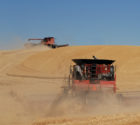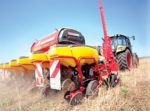Advertise Follow Us
Equipment
Turning Unwanted Discs Into A No-Till Asset
A Kansas farmer invented a five-sided, vertical-tillage blade that he says puts crop residue in touch with soil microbes but still protects the benefits of no-till.
Read More
No-Till Notes
Locate, Correct Compaction For More No-Till Success
Like any field operation, identifying and addressing compaction layers are important to maximize water infiltration, root growth and crop yields.
Read More
Spreading Residue Is Serious Business Across The Pond
Western European farmers and manufacturers are taking residue management more seriously than their counterparts in North America.
Read More
New Tools For Spraying, Planting, Fertilizing Emerge For Farmers
There are more equipment options on the market than ever to help no-tillers and strip-tillers plant precisely, apply fertilizer more efficiently and improve their farm’s bottom line.
Read More
The Next Frontier In Seed Placement Technology
From seed tubes and seed meters to ground sensors, new equipment coming on the scene can help no-tillers achieve more consistent stands and raise planting efficiency and yields.
Read More









